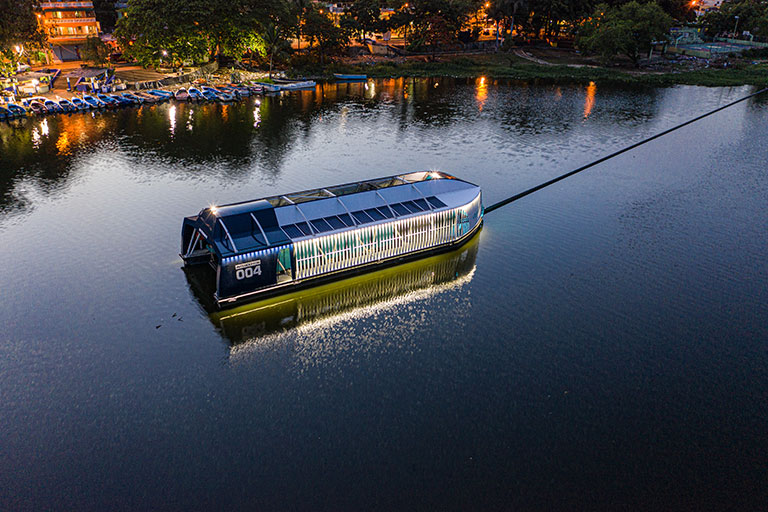The Ocean Cleanup’s Interceptor is a steel-built, automated river-cleaning catamaran that scoops up plastic waste from the water surface, collecting it for recycling and preventing it from reaching the world’s oceans.
Located a few hundred kilometres north of Hawaii is the North Pacific Subtropical Convergence Zone. Here cool waters from the Arctic meet warm currents from the South Pacific to form a 20 million square kilometre vortex of rotating currents.
At the Zone’s eastern and western tips, off the coasts of California and Japan, sit two massive accumulations of ocean debris known collectively as the Great Pacific Garbage Patch.
The vast majority of the plastic and other debris that form the Patch arrived in our oceans from rivers. Rivers are major vectors for the passage of waste from land to sea, and 80 per cent of all river plastic originates from just 1,000 rivers.
To successfully clear the world’s oceans of the plastics that are clogging them and impacting heavily on marine life means more than just tackling garbage patches; it means dealing with the issue at its source.
More sustainable consumption patterns will play a key role, but for confronting the immediate problem there must be a solution for cleaning the world’s most polluting riverways.
Fighting against the flow
The Ocean Cleanup’s answer to this global problem is the Interceptor. A fully scalable solution for preventing plastic from reaching the world’s oceans, this autonomous catamaran is 100 per cent solar powered and can operate in almost all high-polluting rivers.
Able to remove up to 50,000kg of rubbish every day, each Interceptor contains a barge that takes roughly an hour to fill. This barge will be emptied multiple times a day at riverside extraction points and its operation is carefully calibrated to maximise waste collection while allowing other river vehicles to pass safely.
Moving against the current, a debris concentrating barrier extends from the prow of the Interceptor which, combined with the boat’s catamaran design, guides waste into the system.
From the front of the boat a stainless-steel mounted conveyor belt delivers the waste to a shuttle which uses sensor technology to equally fill six containers mounted on a detachable barge until they reach their capacity of a combined 50 square metres of debris.
When the barge is nearly full, it automatically signals local operators who collect the waste from the riverside for transportation to local waste management facilities and the barge is returned to the Interceptor to continue its patrol.
Constructed from marine grade steel, the boat’s structure is high-strength and resistant to the corrosive effects of travelling through polluted waterways, making it resilient to any collisions and giving it an extensive service life.
 The Interceptor can collect up to 50,000kg of river debris a day
The Interceptor can collect up to 50,000kg of river debris a day
Real-world application
The Ocean Cleanup are working directly with governments around the world to rollout this technology where it is needed and there are currently three Interceptors deployed on the world’s rivers.
The prototype Interceptor operates on the Cengkareng Drain in Jakarta, Indonesia, while the other two are deployed on the Klang River in Malaysia and the Rio Ozama in the Dominican Republic.
The plan is to tackle 1,000 rivers in five years, significantly limiting the flow of plastic into the world’s oceans. This is ambitious but meeting a global challenge like marine pollution will require a huge effort.
With the Interceptor’s steel-built resilience, relentless solar powered efficiency and ability to operate almost anywhere in the world, a plastic-free future for the world’s oceans might just be possible.
Images and Video: The Ocean Cleanup